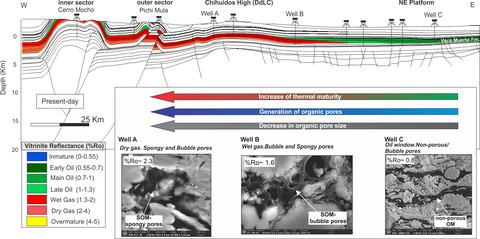当前位置:
X-MOL 学术
›
Basin Res.
›
论文详情
Our official English website, www.x-mol.net, welcomes your
feedback! (Note: you will need to create a separate account there.)
Integrated source rock evaluation along the maturation gradient. Application to the Vaca Muerta Formation, Neuquén Basin of Argentina
Basin Research ( IF 2.8 ) Pub Date : 2021-08-20 , DOI: 10.1111/bre.12599 J. B. Spacapan 1 , M. Comerio 1 , I. Brisson 2 , E. Rocha 3 , M. Cipollone 1 , J. C. Hidalgo 4
Basin Research ( IF 2.8 ) Pub Date : 2021-08-20 , DOI: 10.1111/bre.12599 J. B. Spacapan 1 , M. Comerio 1 , I. Brisson 2 , E. Rocha 3 , M. Cipollone 1 , J. C. Hidalgo 4
Affiliation

|
The Vaca Muerta Formation (Tithonian–early Valanginian) is the main source rock in the Neuquén Basin and the most important unconventional shale resource in South America. In the present study, organic geochemistry, electron microscopy and basin and petroleum system modelling (BPSM) were combined to evaluate source rock properties and related processes along a transect from the early oil (east) to the dry gas (west) window. The unit is characterized by high present-day (1%–8% average) and original (2%–16% average) total organic carbon contents, which increase towards the base of the unit and basinal (west) settings. Scanning electron microscopy shows that organic pores derived from the transformation of type II kerogen. Isolated bubble pores are typical of the oil window, whereas bubble and densely distributed spongy pores occur in the gas stage, indicating that the maturity gradient exerts strong control on organic porosity. Organic geochemistry, pressure and porosity data were incorporated into a 2D basin petroleum system model that includes the sequential restoration of tectonic events and calculation of compaction trends, kerogen transformation, hydrocarbon generation and estimation of pore pressure through geologic time. The W–E regional model extends from the Agrio Fold and Thrust Belts to the basin border and allows us to evaluate the relationship between thermal maturity and timing of hydrocarbon generation from highly deformed (west) to undeformed (east) regions. Modelling results show a clear decrease in maturity and organic matter (OM) transformation towards the eastern basin margin. Maximum hydrocarbon generation occurred in the inner sectors of the belt, at ca. 120 Ma; long before the first Andean compression phase, which started during the Late Cretaceous (ca. 70 Ma). Miocene compression (15–7 Ma) promoted tectonic uplift of the inner and outer sectors of the belt associated with a reduction in thermal stress and kerogen cracking, as well as massive loss of retained fluids and a decrease in pore pressure. The OM transformation impacted (a) the magnitude of effective porosity associated with organic porosity development, and (b) the magnitude and distribution of pore pressure within the unit controlled by hydrocarbon generation and compaction disequilibrium. BPSM shows a progressive increase in effective porosity from the top to the base and towards the west region related to the original organic carbon content and maturity increasing along the same trend. Overpressure intervals with high organic carbon contents are the most prone to develop organic pores. The latter represent favourable sites for the storage of hydrocarbons in the Vaca Muerta Formation.
中文翻译:

沿成熟梯度的综合烃源岩评价。在阿根廷内乌肯盆地 Vaca Muerta 组的应用
Vaca Muerta组(提通阶-早瓦兰吉阶)是内乌肯盆地的主要烃源岩,也是南美洲最重要的非常规页岩资源。在本研究中,有机地球化学、电子显微镜和盆地和石油系统建模 (BPSM) 相结合,以评估沿从早期石油(东)到干气(西)窗口的断面的烃源岩性质和相关过程。该单元的特点是当前(平均 1%–8%)和原始(平均 2%–16%)总有机碳含量高,随着单元底部和盆地(西部)环境的增加而增加。扫描电镜显示有机质孔隙来源于Ⅱ型干酪根转化。孤立的气泡孔是油窗的典型特征,而气泡和密集分布的海绵孔出现在气阶段,表明成熟度梯度对有机孔隙度有很强的控制作用。有机地球化学、压力和孔隙度数据被纳入二维盆地石油系统模型,该模型包括构造事件的顺序恢复和压实趋势的计算、干酪根转化、油气生成和通过地质时间估算孔隙压力。W-E 区域模型从 Agrio 褶皱和逆冲带延伸到盆地边界,使我们能够评估热成熟度与从高度变形(西部)到未变形(东部)地区的油气生成时间之间的关系。建模结果显示成熟度和有机质 (OM) 向盆地东部边缘的转化明显减少。最大的碳氢化合物生成发生在带的内部部分,大约在 120毫安;早在晚白垩世(约 70 Ma)开始的第一个安第斯压缩阶段之前。中新世压缩(15-7 Ma)促进了带内部和外部部分的构造抬升,与热应力和干酪根开裂相关联,以及大量滞留流体损失和孔隙压力降低。OM 转变影响 (a) 与有机孔隙度发育相关的有效孔隙度的大小,以及 (b) 受油气生成和压实不平衡控制的单元内孔隙压力的大小和分布。BPSM 显示有效孔隙度从顶部到底部和向西部地区逐渐增加,与原始有机碳含量和成熟度沿相同趋势增加有关。有机碳含量高的超压区间最容易形成有机孔隙。后者代表了在 Vaca Muerta 地层中储存碳氢化合物的有利地点。
更新日期:2021-08-20
中文翻译:

沿成熟梯度的综合烃源岩评价。在阿根廷内乌肯盆地 Vaca Muerta 组的应用
Vaca Muerta组(提通阶-早瓦兰吉阶)是内乌肯盆地的主要烃源岩,也是南美洲最重要的非常规页岩资源。在本研究中,有机地球化学、电子显微镜和盆地和石油系统建模 (BPSM) 相结合,以评估沿从早期石油(东)到干气(西)窗口的断面的烃源岩性质和相关过程。该单元的特点是当前(平均 1%–8%)和原始(平均 2%–16%)总有机碳含量高,随着单元底部和盆地(西部)环境的增加而增加。扫描电镜显示有机质孔隙来源于Ⅱ型干酪根转化。孤立的气泡孔是油窗的典型特征,而气泡和密集分布的海绵孔出现在气阶段,表明成熟度梯度对有机孔隙度有很强的控制作用。有机地球化学、压力和孔隙度数据被纳入二维盆地石油系统模型,该模型包括构造事件的顺序恢复和压实趋势的计算、干酪根转化、油气生成和通过地质时间估算孔隙压力。W-E 区域模型从 Agrio 褶皱和逆冲带延伸到盆地边界,使我们能够评估热成熟度与从高度变形(西部)到未变形(东部)地区的油气生成时间之间的关系。建模结果显示成熟度和有机质 (OM) 向盆地东部边缘的转化明显减少。最大的碳氢化合物生成发生在带的内部部分,大约在 120毫安;早在晚白垩世(约 70 Ma)开始的第一个安第斯压缩阶段之前。中新世压缩(15-7 Ma)促进了带内部和外部部分的构造抬升,与热应力和干酪根开裂相关联,以及大量滞留流体损失和孔隙压力降低。OM 转变影响 (a) 与有机孔隙度发育相关的有效孔隙度的大小,以及 (b) 受油气生成和压实不平衡控制的单元内孔隙压力的大小和分布。BPSM 显示有效孔隙度从顶部到底部和向西部地区逐渐增加,与原始有机碳含量和成熟度沿相同趋势增加有关。有机碳含量高的超压区间最容易形成有机孔隙。后者代表了在 Vaca Muerta 地层中储存碳氢化合物的有利地点。











































 京公网安备 11010802027423号
京公网安备 11010802027423号